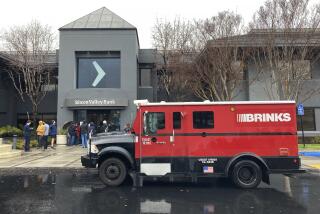Losses at U.S. Thrifts Cut in Half Over Summer : Bank Board Still Glum, Reports Improvement Due Largely to Accounting
- Share via
WASHINGTON — The U.S. thrift industry cut its losses in half between July and September, but the improvement came largely from accounting measures and major problems remain, the Federal Home Loan Bank Board reported Tuesday.
To return to health, the savings and loan industry will need assistance totaling $50 billion, a bank board official said, and most analysts say taxpayers will probably have to pay for some part of the bailout. Other observers have estimated the cost of a bailout at up to $100 billion.
Losses at thrifts narrowed to $1.6 billion during the third quarter from $3.9 billion in each of the two previous three-month periods, the bank board said.
The 3,028 S&Ls; that make up the industry had their best quarter since the first quarter of 1987, when thrifts showed profits of $98 million.
In California, S&Ls; earned net income of $287 million during the quarter, according to the California League of Savings Institutions, compared to $133 million earned in the second quarter. The newly reported figures raised the state industry’s year-to-date earnings to $450 million.
According to the bank board, California was among 33 states with profitable S&L; operations. The $1.6 billion loss reported for the industry nationwide was the equivalent of the losses reported by institutions in Texas alone.
In California, 116 profitable companies had net earnings of $435 million during the quarter. However, the total was reduced by losses reported by 54 otherwise solvent institutions and by 25 firms that are classified as insolvent.
Future improvement nationally depends on interest rates and whether thrifts write down more bad real estate loans, James Barth, the bank board’s chief economist, said at a news conference. Much of the improvement in the third quarter resulted from a sharp drop in losses from writedowns of bad loans, he said.
“The problems in the industry continue to be heavily concentrated in the Southwest, though in fewer thrifts than last quarter since more troubled thrifts have been resolved or stabilized through bank board actions,” Barth said.
He said actions taken by the Federal Savings and Loan Insurance Corp., the insurance arm of the bank board, to close or merge troubled thrifts had contributed to the improvement, but those actions have also dramatically increased the FSLIC’s liabilities.
Barth cautioned that the rise in interest rates could hurt the industry, as higher interest rates did in the early 1980s.
The higher rates could slow the pace of new home loans and raise costs for thrifts that are making adjustable rate mortgages, said Frank Anderson, of the investment banking firm of Stephens Inc., in Little Rock, Ark. “With the big jump in interest rates, a lot of thrifts that have gone heavily into ARMs can’t make money,” he said.
Anderson said the third-quarter results, while encouraging, probably were inflated by the financial aid provided under FSLIC’s Southwest Plan to attract new investors to buy troubled thrifts.
FSLIC has taken action on 154 insolvent thrifts this year and committed $20 billion to merge them with healthier institutions, close them or stabilize them, Barth said.
More to Read
Inside the business of entertainment
The Wide Shot brings you news, analysis and insights on everything from streaming wars to production — and what it all means for the future.
You may occasionally receive promotional content from the Los Angeles Times.










